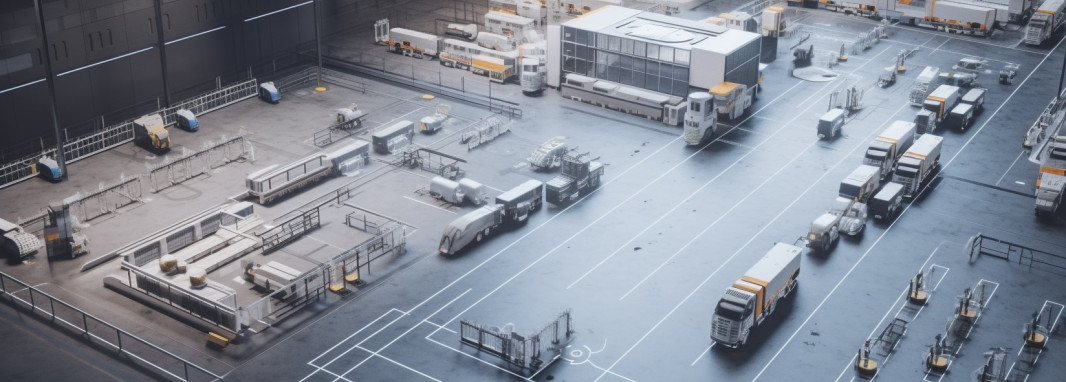The rapid rise of OpenAI's ChatGPT is merely a testament to the broader implications of artificial intelligence across industries.
The realm of logistics, being a pivotal backbone of global commerce, is no exception. The complex interplay of global supply chains, local distributions, and customer interactions is being transformed by the innovative capabilities brought forth by AI.
Let's dive deeper and see where ChatGPT's contemporaries are making waves in the logistics sector and what the future might look like.
ChatGPT's Extended AI Family and Their Input
Apart from ChatGPT, there are a multitude of AI-driven systems specializing in diverse tasks.
For instance, while ChatGPT might excel in customer interaction and data analysis, other AI tools are tailor-made for real-time supply chain adjustments, predictive maintenance of vehicles, or even automated warehousing.
A recent interaction with an AI system, FleetOptim, sheds light on this. When questioned about its role in modern-day logistics, FleetOptim replied, "My primary task is to ensure optimal utilization of fleet resources, monitor vehicle health, and adjust routing in real-time based on traffic patterns."
This response offers a lens into the complementary roles that different AI systems can play within the logistics ecosystem.
Emerging Innovations in AI-Driven Logistics

- Smart Warehousing with Deep Learning: Advanced AI models are now employed to predict inventory levels, optimizing storage space. Using deep learning, warehouses can predict stock requirements months in advance, adjusting for seasonality and market trends. This can be extremely useful whether you have a B2B portal, a B2C store or even a D2C marketplace.
- Autonomous Delivery Vehicles: With self-driving technology progressing rapidly, the day is pretty close when autonomous drones and trucks make deliveries, reducing human intervention and increasing efficiency.
- Blockchain and AI for Supply Chain Authenticity: Incorporating blockchain with AI ensures a tamper-proof supply chain. AI monitors and authenticates every product's journey, ensuring authenticity and reducing counterfeit items.
- Augmented Reality (AR) Assisted Logistics: AR can be incorporated with AI to provide real-time information to ground staff in warehouses or delivery personnel, enhancing efficiency and reducing errors.
- Eco-friendly Logistics through AI: By analyzing vast amounts of data, AI can suggest more sustainable methods of packaging and routes that reduce carbon footprints and even suggest sustainable alternatives for logistics operations.
The Underrated Role of AI in Crisis Management
Logistics can be severely disrupted in unforeseen events such as pandemics, natural disasters, or geopolitical tensions.
Modern AI tools can predict these disruptions and adjust supply chains in real time.
During the recent Suez Canal blockage, AI-driven logistics firms managed to reroute their shipments faster than most, highlighting the importance of real-time decision-making AI in crisis scenarios.
Redefining Customer Interactions: Beyond ChatGPT
While ChatGPT serves as an exemplary model for customer interactions, emerging AI tools like VoicePT and AssistAI transform customer support through voice interactions and virtual assistants.
These systems can handle more complex queries, learn from each interaction, and even handle multilingual support seamlessly.
Future Outlook: A Collaborative AI Ecosystem
The future of logistics is not about one AI system overshadowing others but rather an ecosystem where various AI tools like ChatGPT, FleetOptim, and VoicePT work collaboratively.
They will share insights, learn from each other, and provide a seamless, efficient, and sustainable logistics operation that benefits businesses, customers, and the environment alike.
Top 30 AI Use Cases in Logistics in 2023

Logistics Planning
- Demand forecasting: AI capabilities enable organizations to use real-time data in their forecasting efforts. AI-powered demand forecasting methods reduce error rates significantly.
- Supply planning: Artificial intelligence helps businesses analyze demand in real-time to update supply planning parameters dynamically.
- Carbon Footprint Monitoring: AI assists in monitoring the carbon footprint of logistics activities, ensuring alignment with green initiatives.
Automated Warehousing
Warehouse robots: Warehouse robots enhance businesses' supply chain management, like Amazon's extensive use of robots in their warehouses.
- Damage detection / Visual Inspection: Computer vision technology identifies damages for quality control in warehouse operations.
- Predictive maintenance: AI predicts potential machine failures by analyzing real-time data from IoT sensors.
- Waste Reduction in Warehousing: AI predicts the lifecycle of perishable goods for timely dispatch and consumption.
Autonomous Things
- Self-driving vehicles: Transforming logistics by decreasing dependence on human drivers.
- Delivery drones: Useful for deliveries to places where ground transfer isn't feasible or efficient.
- Personalized Delivery Scheduling: AI offers personalized delivery time slots based on a customer's past delivery preferences.
Analytics
- Dynamic Pricing: Real-time pricing responds to changes in demand, supply, and competition prices.
- Route optimization / Freight management: AI models track and optimize routing.
- Disruption Predictions: AI predicts potential supply chain disruptions, ensuring timely preparations and reactions.
Back office
- Automating document processing: Enhancing efficiency through document automation technologies.
- Automating other manual office tasks: Hyperautomation leverages AI, robotic process automation (RPA), and other technologies for end-to-end automation.
- Fraud Detection: AI identifies suspicious patterns and potential fraud in logistics operations.
Sales & Marketing
- Lead scoring: AI tools assign scores to leads based on profiles, behavior, and interests.
- Routine marketing: AI automates routine marketing tasks for logistics service providers.
- Sales and marketing analytics: AI offers precise analytics for understanding customer behavior and market changes.
Customer service
- Customer service chatbot: Chatbots handle tasks like requesting a delivery, amending an order, and responding to FAQs, enhancing customer service experiences.
Supply Chain Automation
- Supply Chain Transparency: Leveraging AI, logistics companies can offer clients real-time insights into the entire lifecycle of their products, from raw materials to end-user delivery.
- Inventory Optimization: AI predicts which goods will be in demand and automates procurement processes, reducing overstock and stockouts, ensuring optimal inventory levels at all times.
- Supplier Quality Analysis: AI analyzes supplier performance data to identify the best suppliers, ensuring quality and timely deliveries.
Integrated Systems
- ERP and AI Integration: AI can seamlessly integrate with ERP systems to make data-driven decisions, optimize operations, and predict business outcomes.
- Smart Contracts in Logistics: AI can enable the creation and validation of smart contracts, especially in the B2B sector, ensuring secure and efficient transactions.
IoT and AI Synergy
- Fleet Monitoring: AI-driven IoT devices monitor a fleet's health, location, and performance in real-time.
- Temperature-Controlled Logistics: For goods that require specific temperature ranges, AI-driven IoT ensures that these parameters are maintained throughout the delivery process.
Future Innovations
- 3D Printing in Logistics: AI can determine when it's more efficient to 3D print a replacement part on-site rather than ship it.
- VR & AR Enhanced Logistics Training: AI-driven Virtual Reality (VR) and Augmented Reality (AR) tools can provide immersive training experiences for logistics personnel.
- Conversational AI for B2B: Beyond customer service, AI-driven conversational tools can facilitate B2B interactions, automating order placements, and streamlining communications.
Conclusion
The synergy between AI and logistics is evolving rapidly.
With AI systems specializing in diverse logistics components, we're heading towards unprecedented efficiency and sustainability.
As logistics companies continue to embrace these innovations, the industry is set to become more resilient, adaptable, and customer-centric.






